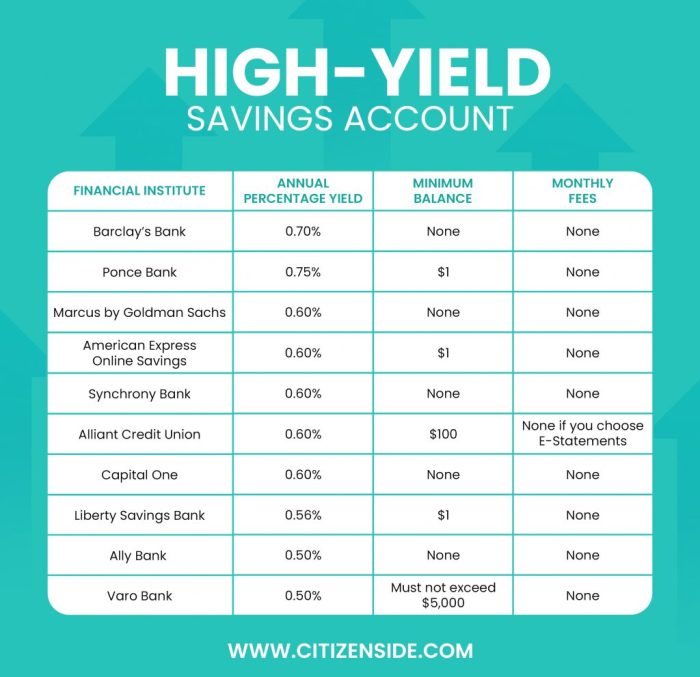Get ready to dive into the world of High-yield savings accounts, where financial savvy meets opportunity. This ain’t your average savings account talk – we’re breaking down the key deets and showing you how to make your money work harder for you.
So buckle up and get ready to learn how to level up your savings game with High-yield accounts.
What are high-yield savings accounts?
High-yield savings accounts are specialized savings accounts offered by financial institutions that provide a higher interest rate compared to traditional savings accounts. These accounts are designed to help individuals grow their savings faster by earning more interest on their deposits.
Key Features of High-Yield Savings Accounts
- Competitive Interest Rates: High-yield savings accounts offer significantly higher interest rates than regular savings accounts, allowing account holders to earn more on their deposited funds.
- No Minimum Balance Requirements: Unlike some traditional savings accounts, high-yield savings accounts usually do not require a minimum balance to open or maintain the account.
- Limited Monthly Transactions: Most high-yield savings accounts have restrictions on the number of withdrawals or transfers allowed per month to encourage saving rather than frequent spending.
- Federal Deposit Insurance: Just like traditional savings accounts, high-yield savings accounts are typically FDIC-insured up to the maximum allowed by law, providing account holders with security for their funds.
Benefits of High-Yield Savings Accounts
- Higher Interest Earnings: The primary advantage of high-yield savings accounts is the potential for account holders to earn more interest on their savings, helping their money grow faster over time.
- Low Risk: High-yield savings accounts are considered low-risk investments since they are typically backed by the government and offer a guaranteed return on deposited funds.
- Liquidity: While high-yield savings accounts may have some restrictions on withdrawals, they still offer easy access to funds in case of emergencies or unexpected expenses.
- Easy to Open and Manage: Opening a high-yield savings account is a straightforward process, usually requiring minimal paperwork and allowing for convenient online management of funds.
How do high-yield savings accounts work?

High-yield savings accounts work by offering a higher interest rate compared to traditional savings accounts. This allows account holders to earn more money on their savings over time.
Mechanics of interest accrual in high-yield savings accounts:
- Interest is typically compounded daily or monthly, which means that the interest earned is added to the account balance regularly. This allows for faster growth of savings.
- Higher interest rates in high-yield savings accounts are often variable, meaning they can change based on market conditions.
- Some high-yield savings accounts may have minimum balance requirements to earn the advertised interest rate.
Examples of financial institutions offering high-yield savings accounts:
- Ally Bank: Offers a competitive interest rate on their Online Savings Account.
- CIT Bank: Provides a high-yield savings account called Savings Builder with tiered interest rates based on balance.
- Discover Bank: Offers an Online Savings Account with no minimum balance requirement and competitive interest rates.
Comparison of interest rates offered by different banks:
| Financial Institution | Interest Rate |
|---|---|
| Ally Bank | 0.50% |
| CIT Bank | Up to 0.50% |
| Discover Bank | 0.40% |
Factors to consider when choosing a high-yield savings account
When choosing a high-yield savings account, there are several factors to consider to ensure you are making the best decision for your financial goals.
APY (Annual Percentage Yield)
APY is the total amount of interest you will earn on your savings account over one year, including compound interest.
– Look for accounts with higher APYs to maximize your earnings over time.
– Compare different banks and financial institutions to find the best APY rates available.
– Consider whether the APY is fixed or variable, as this can impact your long-term savings strategy.
Minimum Balance Requirements
When evaluating high-yield savings accounts, it is essential to consider the minimum balance requirements set by each financial institution.
– Some accounts may require a minimum balance to open the account, while others may have ongoing minimum balance requirements to avoid fees.
– Be sure to choose an account with minimum balance requirements that align with your current financial situation and savings goals.
– Keep in mind that some accounts may offer higher APYs but have higher minimum balance requirements, so weigh the trade-offs carefully.
Tips for maximizing returns with high-yield savings accounts
When it comes to high-yield savings accounts, there are strategies that can help you optimize your savings and make the most of your money. Understanding how compounding interest works and effectively managing your account are key to increasing your returns.
Impact of compounding interest on savings in a high-yield account
Compounding interest is the interest earned on both the initial deposit and the interest that has already been added to the account. This means that your savings grow faster over time, as you earn interest on your interest. To maximize this effect, it’s important to regularly deposit funds into your high-yield savings account and avoid making frequent withdrawals.
Guidance on managing and monitoring a high-yield savings account effectively
To effectively manage your high-yield savings account, set up automatic transfers from your checking account to ensure regular deposits. Monitor your account regularly to track your progress towards your savings goals and take advantage of any promotional offers or higher interest rates. Consider setting up alerts for any significant changes in your account balance or interest rates to stay informed and make adjustments as needed.
